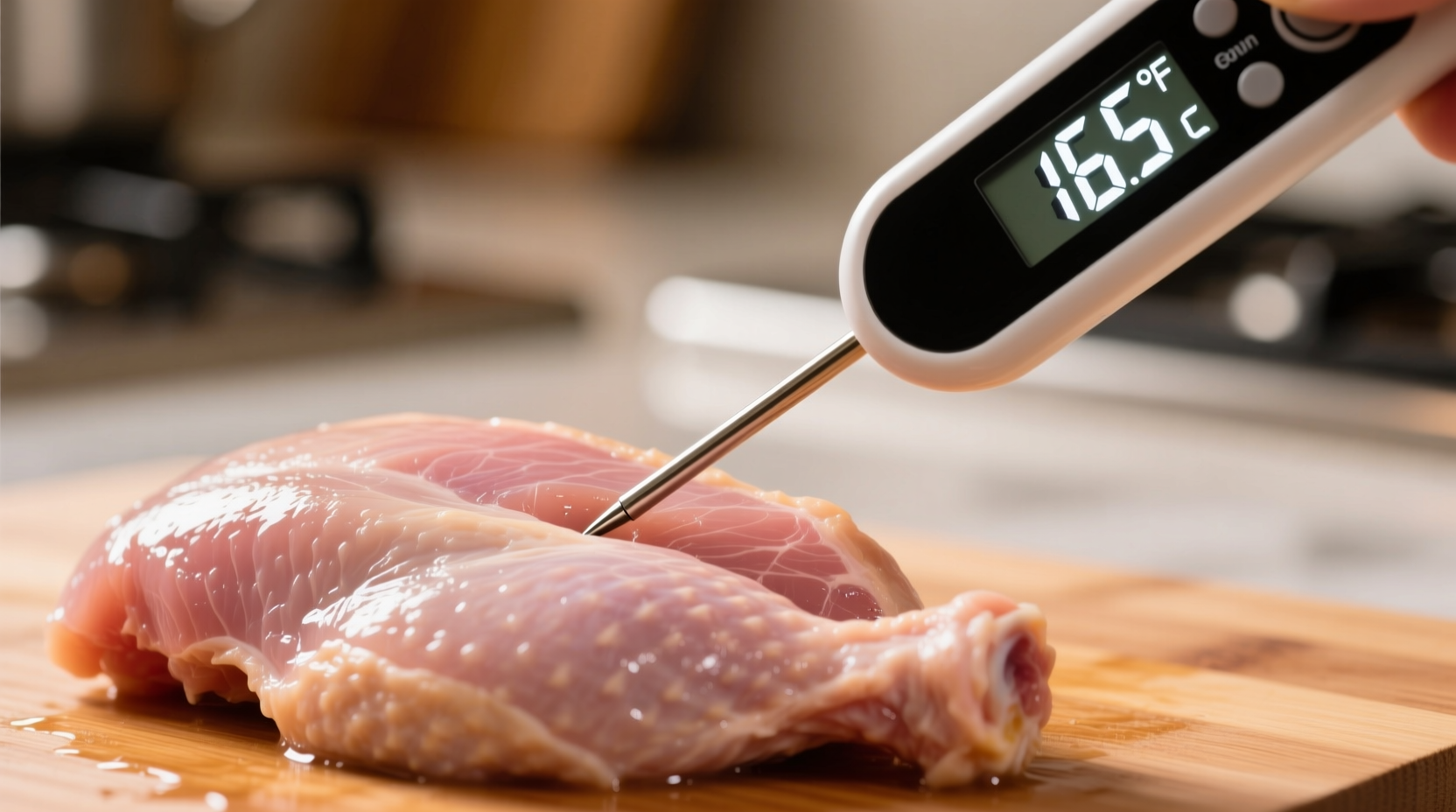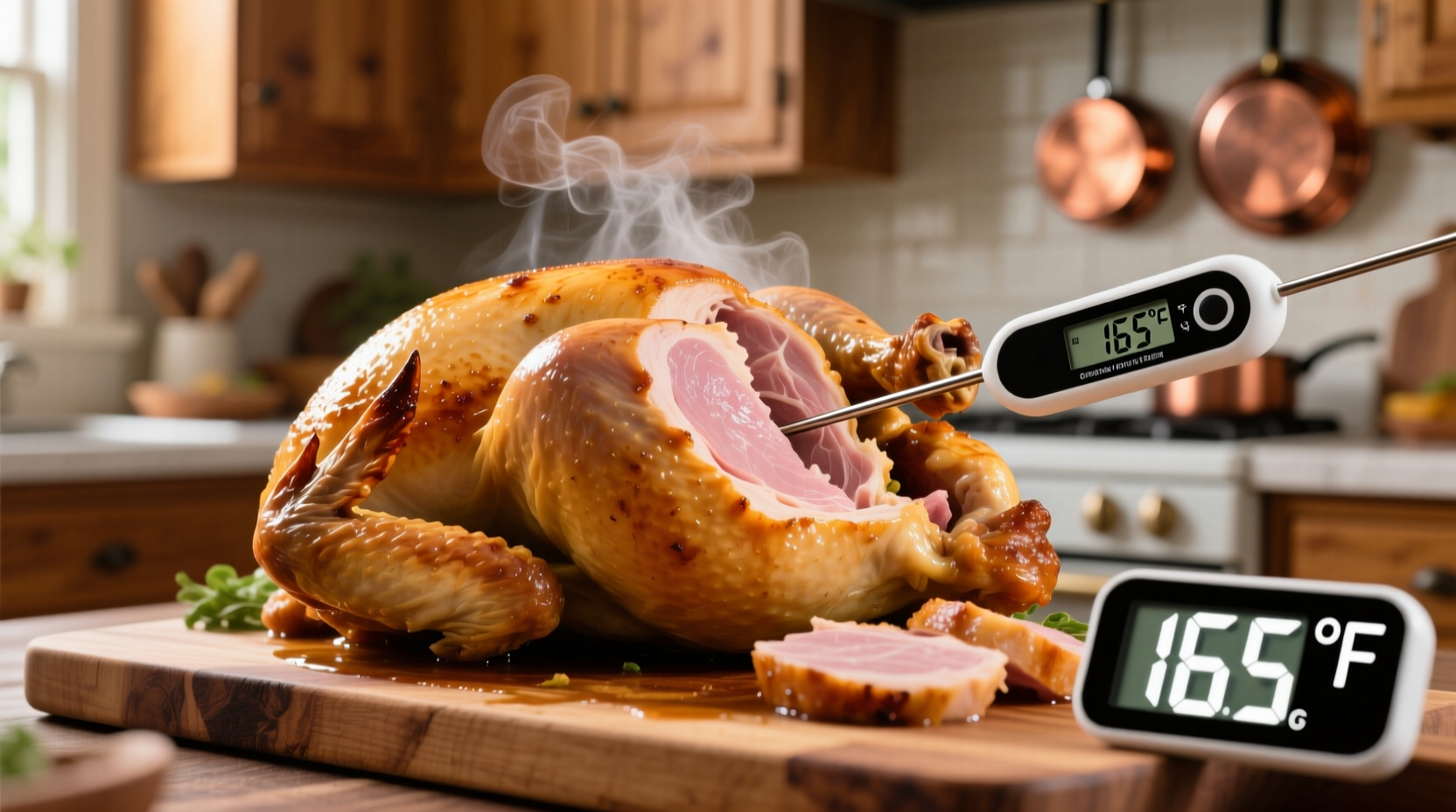When cooking chicken, getting the temperature right isn't just about doneness—it's a critical food safety requirement. Millions of people experience food poisoning annually from undercooked poultry, yet many home cooks still rely on unreliable visual cues like color or cooking time. This guide delivers precise, science-backed temperature guidance you can trust, with practical measurement techniques that eliminate guesswork.
Why 165°F Is the Safety Threshold
The USDA's 165°F (74°C) standard for chicken isn't arbitrary—it's based on pathogen destruction kinetics. At this temperature, harmful bacteria including salmonella and campylobacter die almost instantly. Lower temperatures require longer exposure times to achieve the same safety level:
| Temperature | Time to Destroy Pathogens | Practical Application |
|---|---|---|
| 140°F (60°C) | 26 minutes | Not recommended for home cooking |
| 150°F (66°C) | 2.8 minutes | Sous vide only with precise timing |
| 160°F (71°C) | 14.8 seconds | Acceptable for dark meat with carryover cooking |
| 165°F (74°C) | Instant | USDA standard for all chicken parts |
While some chefs advocate for lower temperatures with extended timing (particularly for sous vide cooking), the USDA maintains 165°F as the universal standard for home kitchens where precise time-temperature control is challenging. This recommendation aligns with international food safety authorities including the FDA Food Code and European Food Safety Authority.
Measuring Temperature Like a Professional
Proper thermometer placement determines accuracy. For chicken breasts, insert your instant-read thermometer into the thickest part, avoiding bone and fat pockets. With whole chickens, check three critical zones:
- Inner thigh (without touching bone)
- Thickest part of breast
- Area between drumstick and body
Thermometer quality matters—calibrate regularly by testing in ice water (should read 32°F/0°C) or boiling water (212°F/100°C at sea level). Digital probe thermometers provide faster, more accurate readings than dial models. Always clean your thermometer with hot, soapy water between measurements to prevent cross-contamination.

Temperature Variations by Cooking Method
Different cooking techniques require nuanced temperature approaches while maintaining the 165°F safety threshold:
- Grilling: Remove chicken at 160°F—carryover cooking will reach 165°F during 3-5 minute rest
- Sous vide: Can safely cook at 145°F for 30+ minutes, but 165°F remains simplest standard
- Slow cooking: Must reach 165°F eventually, though cooking occurs at lower temperatures
- Frying: Check internal temp after browning—exterior color doesn't indicate doneness
Debunking Common Chicken Cooking Myths
Many home cooks rely on dangerous misconceptions that increase foodborne illness risk:
Myth: "Clear juices mean chicken is done"
Fact: USDA research shows colorless juices can occur below 165°F—only a thermometer provides certainty.
Myth: "Cooking for X minutes guarantees safety"
Fact: Cooking time varies dramatically based on thickness, starting temperature, and equipment.
Myth: "Slightly pink chicken is unsafe"
Fact: Some chicken remains pink even at 165°F due to myoglobin reaction—temperature, not color, determines safety.
Special Considerations for Different Chicken Cuts
While the 165°F standard applies universally, different cuts have unique characteristics:
- Bone-in pieces: Require 5-7°F lower reading than boneless due to heat conduction differences
- Stuffed chicken: Must reach 165°F in both chicken and stuffing center
- Ground chicken: More surface area requires strict 165°F compliance (no medium-rare option)
- Brined chicken: May appear done earlier—always verify with thermometer
For optimal texture, remove chicken from heat at 160-162°F and allow 5-10 minutes resting time. During this period, internal temperature will rise 3-5°F through carryover cooking while juices redistribute.
Essential Food Safety Practices Beyond Temperature
Temperature control is just one component of safe chicken preparation. Always:
- Prevent cross-contamination using separate cutting boards for raw and cooked chicken
- Wash hands thoroughly after handling raw poultry
- Refrigerate leftovers within 2 hours (1 hour if above 90°F/32°C)
- Thaw frozen chicken in refrigerator, not on counter
- Marinate in refrigerator, never at room temperature
According to CDC data, proper cooking temperature prevents approximately 1.2 million salmonella cases annually in the United States alone. When in doubt about doneness, check with your thermometer—your health depends on it.
Frequently Asked Questions
Can chicken be safe at 160 degrees?
Yes, dark meat like thighs can be safe at 160°F with proper resting time, as carryover cooking typically raises temperature to 165°F. However, the USDA maintains 165°F as the universal standard for all chicken parts to eliminate confusion and ensure safety across all cooking scenarios.
How long after reaching 165°F is chicken safe to eat?
Chicken is immediately safe to eat once it reaches 165°F throughout. Bacteria are destroyed instantly at this temperature. However, allowing 5-10 minutes of resting time improves texture and juiciness while maintaining safety.
Does oven temperature affect the required internal temperature?
No, the required internal temperature of 165°F remains constant regardless of cooking method or oven temperature. Higher oven temperatures cook chicken faster but don't change the safety threshold. Always verify with a thermometer, not cooking time.
Is slightly pink chicken under 165°F ever safe?
No. Pink color can persist in properly cooked chicken, but any chicken below 165°F may contain live pathogens. The USDA emphasizes that color is unreliable—only a food thermometer provides definitive safety verification. Never serve chicken that hasn't reached 165°F internally.











 浙公网安备
33010002000092号
浙公网安备
33010002000092号 浙B2-20120091-4
浙B2-20120091-4